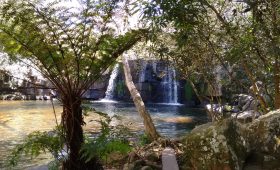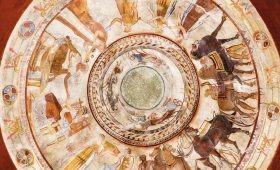Exploring Notsé, Togo: A Journey Through History and Culture
Notsé, located about 100 kilometers north of Lomé in Togo’s Plateaux Region, offers a unique blend of history and culture. As the capital of Haho Prefecture, this town is a significant site for the Ewe people, who settled here around the 15th century. If you’re interested in history and local traditions, Notsé provides an intriguing destination.
Historical Significance
Notsé is historically important as the former center of the Ewe Kingdom. The town’s origins trace back to the Ewe people’s migration from the Nile Valley, through regions like Oyo in Nigeria and Ketou in Benin. One of the most notable historical features is the remains of the “Agbogbo” wall, a 14.5-kilometer mud wall built to protect the Ewe from enemies and slave raiders. This wall stands as a testament to the town’s rich past and the resilience of its people.
Natural and Cultural Attractions
While Notsé may not boast dramatic landscapes, it is known as the pineapple capital of Togo, offering a taste of local agriculture. The town is surrounded by lush greenery, and the nearby Mono River adds to the area’s natural charm. The annual “Agbogbo-Za” festival is a highlight, celebrating the Ewe people’s exodus in the 17th century. This event is a vibrant display of traditional music, dance, and rituals.
Best Time to Visit
For a comfortable visit, plan your trip between November and February. This period offers mild temperatures and lower humidity, making it ideal for exploring. The dry season also ensures clearer skies, enhancing your experience of the local scenery. Be cautious of the rainy season, as heavy rains can limit access to certain areas.
Getting There
Travelers can reach Notsé via Lomé-Tokoin International Airport, Togo’s main international gateway. From Lomé, Notsé is about a three-hour drive. Taxis and local buses are available for the journey, which offers scenic views of the Togolese countryside.
Local Transportation
Once in Notsé, getting around is straightforward. Motorcycle taxis, known locally as “zemidjans,” are a popular and affordable option. They provide a quick way to navigate the town. Alternatively, renting a bicycle allows for a more leisurely exploration of Notsé’s streets and neighborhoods.
Experiencing Local Culture
To truly experience Notsé, visit the local markets. The Notsé Market, held every Saturday, is a lively hub of activity. Here, you can sample local dishes like “fufu,” made from pounded cassava or yam, accompanied by a variety of sauces. The market is also a great place to interact with locals and gain insight into daily life in Notsé.
- Notsé is a historically significant town for the Ewe people in Togo.
- The “Agbogbo” wall is a notable historical landmark.
- Notsé is recognized as the pineapple capital of Togo.
- The best time to visit is between November and February.
- Lomé-Tokoin International Airport is the main entry point to Togo.
- Zemidjans are a common form of transportation in Notsé.
- The Notsé Market offers a vibrant cultural experience.




